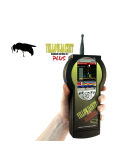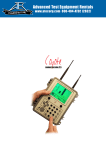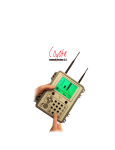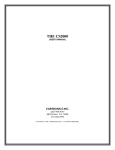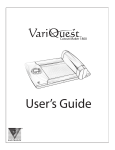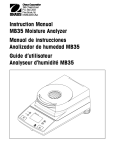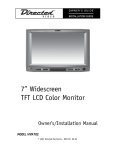Download Compaq Wolf User's Manual
Transcript
WOLF manual version 1.2 Contents INTRODUCTION................................................................................................. STARTING UP................................................................................................... Wolf ACCESSORIES............................................................................................ STARTUP SCREEN............................................................................................. FREQUENCY STEPS............................................................................................ MAIN MENU..................................................................................................... SINGLE CHANNEL ANALYSIS................................................................................. CHANNEL TABLE............................................................................................... SPECTRUM ANALYSIS......................................................................................... BEST SERVER LIST............................................................................................ REALTIME CLOCK AND MARKERS........................................................................... DATA RECORDING.............................................................................................. SNAPSHOTS.................................................................................................... DATA CONVERSION USING CHAMELEON CW.............................................................. BATTERY CHARGING SYSTEM............................................................................... TROUBLESHOOTING........................................................................................... BATTERY TIPS.................................................................................................. CHAMELEON SOFTWARE (WOLF EDITION)................................................................ BVS CHANNEL TABLE EDITOR SOFTWARE................................................................. GLOSSARY OF ACRONYMS GENERAL SAFETY Wolf DATA SHEET Page 1 2 2 2 4 4 4 5 5 6 7 7 7 8 8 9 9 10 11 12 INTRODUCTION Wolf™ is a wireless multi-band signal meter system that works with the iPAQ® PocketPC® in sweeping, analyzing and optimizing indoor and outdoor wireless networks. The receiver measures both Cellular 868-896 MHz and PCS 1930-1995 MHz demodulating both bands and delivering vital wireless data. Measurements include full spectrum sweep, channel comparisons, best servers, adjacent channels and more. Wolf™ allows those familiar with the iPAQ’s PocketPC® interface a unique advantage over “software only” products currently available because Wolf™ functions as a complete indoor analysis system combining the ubiquitous PocketPC® environment along with Berkeley’s precision receiver technology. Wolf receiver (top view) has an SMA male connector for the supplied antenna. Wolf receiver may be powered here for desktop use using the supplied transformer. This manual contains operational procedures to get the user up-and-going right out of the box. For any details regarding the iPAQ, users should read all materials from Compaq and contact them. STARTING UP Wolf Power up your Wolf by pushing power button in upper right corner of unit. This power will automatically power up the Wolf receiver also. When you power down the iPAQ, (push the power button on the upper right quickly-holding this button will also toggle the backlight on and off) your Wolf receiver will also shut down. Connect the included antenna to the SMA connector and remove the stylus by pushing down on it. Use your stylus to tap onto the Windows® icon in the upper left corner. Choose Wolf in the pulldown menu. Data may be transferred to a PC via the IrDA window or USB or serial connection. Install Wolf software by connecting your iPAQ to your PC and inserting included BVS software CD-ROM into PC to begin installation. You may also use the provided Compact Flash Installer card. Wolf ACCESSORIES Your Wolf includes the following accessories: antenna, 2 sets of AA (Ni-MH) removable batteries (8 total), Simply insert depleted batteries into charger and plug charger into AC outlet. See top of charger for LED status indicator lights (see end of manual for charger specs). Approximate charging time for 4 Ni-MH batteries is just over one hour. Run time is just over two hours. Wolf uses common AA battery cells found in Page 2 any convienence store. Ni-Cad, Alkalines, Ni-MH and Li-Ion cells may all be used. Wolf does require 4 AA cells with at least 1500 mAh per cell. BVS supplies 2 battery sets (8 Ni-MH battery cells total) to get users working right out of the box. Ni-MH cells are recommended for best performance from your Wolf. Batteries that are warm or hot to the touch (from constant usage or warm ambient temperatures) will take longer to charge than batteries of a normal temperature. Contact BVS for new Ni-MH battery packs. Expect over 500 cycles from each Ni-MH pack. iPAQ model 3955 (optional) inside iPAQ cradle. The included Compact Flash Backup Installer card can be used to install the Wolf Data Logger application when the iPAQ’s internal battery has completely drained and a PC is not handy. Simply insert this card into the iPAQ sleeve that attaches to the Wolf receiver and install the software using your iPAQ from there. Always make sure batteries are fully charged when doing any software installs. See TROUBLESHOOTING section at the end of this manual for battery charging and removal procedures. iPAQ / Wolf charger Wolf calibrated receiver eight AA NiMH batteries Wolf Compact Flash Backup Installer antenna iPAQ charging cradle. Direction Finding Antenna (optional) Rayovac® Ni-MH fast charger with AC adapter and auto adapter Page 3 Startup Screen The Wolf software can be started by: 1. Pressing the Start button on the Ipaq. 2. Pressing the “BVS Wolf” program option from the main drop-down list. 3. Tapping anywhere on the screen when the splash screen appears as shown below. Frequency Steps After you tap on the startup screen, you will see this frequency step menu screen. You must choose your frequency kHz steps in either 30kHz, 50kHz or 200kHz increments. Choose your frequency steps to proceed to the main menu. Main Menu The main menu of the Wolf software contains option buttons in the main viewing area and a series of toolbar options. The main viewing area is shown below. There are four choices in the main viewing area. You may choose single channel analysis, which allows selection of a single channel on either or both bands. There is the channel table selection, which allows up to 30 channels to be selected for analysis. These channels can be in either band. There is the spectrum analyzer-type screen which will show all RF being received within the range of the receiver, the range being decided upon by the user. The final option is the best server screen. This option shows the frequencies with the strongest received signal strength in a particular band. Page 4 The toolbar (shown below) gives the user more options on every screen. The first icon has five interconnected colored circles. Using this option will always return the user to the main menu. The second and third icons are arrows pointing upward and downward. These options have different uses depending on the currently active screen. For instance, on the access point screen, the arrows are used to flip the current page of access points. The fourth icon represents a camera. This option takes snapshots of the current screen for later viewing. The pictures are stored in JPEG format. The “record” button is for logging a data file. The “stop” button is for terminating the logging of data. The “play” button will be implemented in a later version of the software. The icon with the letters “ABCD” enters the system options screen. The question mark icon reveals the application about box. Single Channel Analysis The “Single Channel” option allows users to choose a single channel from either/both bands to view over a period of time. When pressing the “Single Channel” button, an option screen will appear. Place a checkmark by each band you wish to examine. Then choose the frequency or channel in each band selected . After then pressing OK, a bar graph and an “over time” graph will appear for each of the channels selected. Page 5 Channel Table The channel table screen allows a user to select up to 30 channels in either band for closer inspection. These channel ‘lists’ are created with the separate channel table editor which runs on the PC. After pressing the channel table button on the main menu, select a file on the iPAQ containing the desired channel table for this scan. After the table has been selected, the channel table display screen will appear and begin scanning. Spectrum Analysis The spectrum analysis feature of the Wolf allows a user to view any RF signals that is received by the receiver. It uses frequency for the X-axis and RSSI (received signal strength indicator) in dBm on the Y-axis. When pressing the spectrum analysis button on the main menu, an option screen appears. Here is where the band, center frequency, and span (in MHz or channels) are set. Be aware not to choose a span that is wider than the width of the band. For example, the cellular band is 869.01-893.97, therefore the maximum width is 24.96 MHz, using 881.52 as an approximate center frequency. After these options have been set, the ‘OK’ button will bring the user into the spectrum screen itself. The white bar moving horizontal across the screen is there to show that the unit is indeed scanning. Similar to the radar sweep indicator which is found on radar. There are three available traces. They are red, blue, and yellow traces. Only one trace can be active at any one time. Each of the three traces can be made visible by pressing their respective “visible” buttons. The active trace can be peak held by pressing it’s “hold trace” button. Page 6 Use the “marker to peak” button to move the diamond marker to the current highest dBm valued point. Use the “marker to center” button to move the diamond marker to the center of the currently displayed section. There are also buttons for moving the diamond peak mark to the left or right in the currently displayed screen. Each spectrum screen displays information regarding the center frequency of the screen as well as the span in MHz. The current marker position and value is also displayed. Best Server List The best server point list screen provides the user with a list of top frequencies from a particular band as seen by the receiver. The user is prompted to choose which band is to be used for the search. Then, after pressing OK to the particular band, the hardware will search through all channels on that band. After completing a sweep of all channels, the top 10 channels will be shown. The frequency, channel number, and RSSI will be shown for each entry. The list is updated after every sweep. Real-Time Clock and Markers It is noted that the blue bar on some screens show the iPAQ date and time as provided by the operating system. This date and time is used for marking logged records with a reference point in time. There is also a marker number. When the INC button is pressed on this bar, the marker number will increment. This is also used in log files for a reference point to interesting data collection anomalies. Data Recording When the “record” button icon is pressed from the toolbar at the bottom of the screen, the user will be prompted for a filename. This filename will be used to store collected data for later conversion by Chameleon CW. Page 7 The data is stored in a compact proprietary binary format. The Wolf will store data as it received from the hardware, depending on the currently active screen. If the spectrum screen is currently active, spectrum data will be stored. If the access point screen is currently active, access point information will be stored. To save the collected data, press the “stop” button icon. To view the size of the log file while still logging, simply return to the main menu screen. WARNING! : Make sure that the “stop” button is pressed to avoid the loss of data saved. Snapshots When the camera icon is pressed from the toolbar at the bottom of the screen, a snapshot of the currently viewable display is taken. The snapshot can be saved as a JPEG format picture (just like a digital camera) for viewing at a later time or for importing into documents and reports. As an example, the images of the Wolf screens shown in this section of the manual were saved using this option. Data Conversion (using Chameleon (Wolf Edition)) Data that has been logged by the Wolf is stored in a proprietary binary format. It can be transferred to a PC or laptop. Once on the PC or laptop, the Chameleon utility application can be used to convert the binary data into an ASCII-readable format that can be imported into spreadsheet applications such as MS Excel or other applications that accept ASCII-delimited data. Page 8 Charging System The Wolf has 2 different battery sources that need charging power. There is an internal battery for the Pocket PC and removable batteries for the receiver module. The 4 AA Ni-MH receiver batteries may only be charged using the supplied fast charger or another comparable Ni-MH charger. The Compaq iPAQ internal battery may be charged by either plugging in the supplied power transformer or by inserting the iPAQ PDA into the supplied charging / data transfer cradle. The BVS supplied charger will power the Wolf receiver AND power and charge the iPAQ PDA. Batteries for the Wolf receiver (4 AA cells) must be charged in the provided charger. See Compaq’s documentation for complete charging instructions. Troubleshooting If your Wolf is not responding, be sure to check all battery and cable connections. Check Compact Flash end of connector that slides into top of iPAQ and other end of cable that connects to Wolf receiver To access batteries under iPAQ: 1. Slide iPAQ back and away from antenna end of receiver. Be sure not to pull too hard or crimp the cable in any way. NEVER remove the Compact Flash connector from the iPAQ sled unless troubleshooting for connectivity issues. 2. Flip over iPAQ exposing the battery compartment on the top of the Wolf receiver. 3. Pull up tab on battery cover to expose 4 Ni-MH AA batteries. Change these batteries for fresh Ni-MH batteries and repeat steps above in reverse order. • Cannot Open Com Port or System Not Responding – Try restarting the application. If the system locks up completely, press the small reset button located at the bottom of your iPAQ. See Compaq’s usage instructions for more info on performing a hard reset. • Wolf software is missing or corrupted You can find the Wolf application in the BVS Software CD (red writing) included with your Wolf. Re-install your Wolf software. Users may experience COM PORT communication problems when moving from Bird’s Eye Site Surveyor to Wolf Data Logger in Pocket PC 2002. This may be remedied by simply pushing the reset switch on the bottom of the iPAQ. BATTERY TIPS Page 9 Use this included power adapter for 3800 or 3900 series iPAQs with no separate power input. The Grasshopper™, Locust™, Yellow Jacket™ and Yellow Jacket Plus (fomally called Scorpion), Beetle™, Cricket™, and Cicada W-LAN receivers use 4 or 5 Ni-MH long-lasting “AA Cells”. 1. Ni-MH batteries do not charge to full capacity the first time they are charged. 2. Ni-MH batteries do not charge to full capacity the first time they are charged after a long period of inactivity. or after a long period of non-use. Cause: When charging Ni-MH batteries for the first time after long-term storage, deactivation of reactants may lead to increased battery voltage and decreased capacity, (which causes premature termination of charging). Because batteries are chemical products involving internal chemical reactions, performance deteriorates with prolonged storage. This is normal in Ni-MH batteries. Resolution: Ni-MH batteries may not charge to full capacity the first time they are charged, or after a long period of inactivity. The first-time charge of the Ni-MH Rechargeable Battery Pack should take approximately 2 hours. If the Receiver Dock light turns green, indicating a full charge, in less than 2 hours, repeat the charge cycle as follows: First-time Charge: 1. To begin charging, place the instrument on the Charge Dock. Refer to your instrument’s User Guide for details. 2. When the charge light turns green, remove the W-LAN Receiver from the dock and place back on the dock after several seconds. 3. Repeat steps 1 and 2 three or four times or until the combined charge time is 2 hours. Subsequent charges of the W-LAN Ni-MH Battery Pack will not require multiple charging cycles unless left uncharged for a long period of time (greater than 2 months). Chameleon (Wolf Edition) NOTE: In order to prevent the Ipaq from freezing when running Wolf software (therefore rendering the power button useless), make sure to: 1. ALWAYS leave the checkboxes in the SETTINGS/SYSTEM/POWER screen unchecked. Power-save mode will lock up the application due to the fact that the application is stopped while communicating with the hardware.. 2. Make sure that the battery level on the Ipaq remains above 40%. The serial card interface may cease to operate when the battery level is under 40%. To resolve the freeze, simply press the soft reset button on the bottom of the Ipaq with the stylus. NEVER LEAVE THE IPAQ ON FOR EXTENDED TIMES (10 HOURS OR GREATER) WITHOUT EXTERNAL POWER. ALWAYS SAVE ANY DATA AND THEN TURN OFF IPAQ (TOP RIGHT POWER BUTTON) WHEN NOT IN USE. NOT DOING SO WILL RESULT IN DAMAGE TO THE IPAQ’S INTERNAL BATTERY. Page 10 In the PocketPC’s OS, choose Settings and then choose System settings at the bottom. Select the battery icon for Power Settings to access this screen. These power settings come unchecked from the BVS factory to ensure Wolf software runs optimally. Power must remain on during logging or else data might be corrupted. PC Application The Chameleon application converts data logged by the Wolf into an ASCII delimited file for use in postprocessing. The data converted is based on correlation records collected in the measurement mode of the iPAQ Wolf Receiver Interface. To convert a file, use the following steps: 1. 2. 3. 4. 5. 6. 7. 8. Copy the log file off of the iPAQ and onto your desktop or laptop. Run the Chameleon application. Click BROWSE on the Input File line to choose a file to convert. A default output filename will be created. Change if needed. Choose which fields you wish to have in the output file. Choose the delimiter to place between fields. Choose whether or not you would like a header record with titles for each column. Press the CONVERT button. The progress bar will monitor the progress of the conversion. Page 11 BVS Channel Table Editor The BVS Channel Table Editor is a utility program that runs on your PC. It is used to create channel tables that can then be used for Wolfpack scanning or as a channel table on the base Wolf software. You can enter up to 30 different channels or frequencies. You can modify an existing table or create a new table by pressing the associated buttons. When entering data into the table, you must: 1. Select the band (0 is the Cellular Band, 1 is the PCS band). 2. Choose either a channel number or a frequency. If you choose a channel number, the associated frequency will adjust when leaving the edit field. If you choose a frequency, the associated channel number will change when you leave the edit field. When you are done, save the file (will be a .BCT file). Then you move the table over to the iPAQ through ActiveSync. Place the file into the “My Documents” folder on the iPAQ. Then you can import the table into the appropriate software (Wolf or Wolfpack). Page 12 Glossary of Acronyms AC A/D AGC AP Applet BER BPSK BSS BW CDMA DC D/A dB dBm DOS DSP DSSS ESS FHSS FIR GHz IF I and Q IBBS IrDA kHz LCD LO MAC Mbits MHz NIC OFDM PC PCS PER PN QPSK RF RSSI SSID STA UCT VAC VGA WEP WLAN Alternating Current Analog to Digital converter Automatic Gain Control Access Point a small Application Bit Error Rate Binary Phase Shift Keying Basic Service Set Band Width Code Division Multiple Access (spread spectrum modulation) Direct Current Digital to Analog decibel decibels referenced to 1 milliwatt Digital Operating System Digital Signal Processing Direct Sequence Spread Spectrum Extended Service Set Frequency-Hopping Spread Spectrum Finite Impulse Response GigaHertz Intermediate Frequency In phase and Quadrature Independent Basic Service Set Infrared Data Association kiloHertz Liquid Crystal Display Local Oscillator Medium Access Control Megabits MegaHertz Network Interface Card Orthogonal Frequency Domain Multiplexing (802.11a) Personal Computer Personal Communications Service (1.8 to 2.1 GHz frequency band) Packet Error Rate Pseudo Noise Quaternary Phase Shift Keying, 4-level PSK Radio Frequency Receiver Signal Strength Indicator Service Set IDentification STAtion (generally a laptop WLAN card) Universal Coordinated Time Volts Alternating Current Video graphic Wired Equivalent Protocol Wireless Local Area Network Page 13 IMPORTANT SAFETY INSTRUCTIONS When using your telephone equipment, basic safety precautions should always be followed to reduce the risk of fire, electric shock and injury to persons, including the following: 1)Read and understand all instructions. 2)Follow all warnings and instructions marked on the product. 3)Unplug this product from the wall outlet before cleaning. Do not use liquid cleaners or aerosol cleaners. Use a damp cloth for cleaning. 4)Do not use this product near water, for example, near a bath tub, wash bowl, kitchen sink, or laundry tub, in a wet basement, or near a swimming pool. 5)Do not place this product on an unstable cart, stand, or table. The product may fall, causing serious damage to the product. 6)Slots and openings in the cabinet and the back or bottom are provided for ventilation, to protect it from overheating these openings must not be blocked or covered The openings should never be blocked by placing the product on the bed, sofa, rug or other similar surface. This product should never be placed near or over a radiator or heat register. This product should not be placed in a built-in installation unless proper ventilation is provided. 7) This product should be operated only from the type of power source indicated on the appliance. If you are not sure of the type of power supply to your home, consult your dealer or local power company. 8)Do not allow anything to rest on the power cord. Do not locate this product where the cord will be abused by persons walking on it. 9)Do not overload wall outlets and extension cords as this can result in the risk of fire or electric shock. 10)Never push objects of any kind into this product through cabinet slots as they may touch dangerous voltage points or short out parts that could result in a risk of fire or electric shock. Never spill liquid of any kind on the product. 11) To reduce the risk of electric shock, do not disassemble this product, but take it to a qualified service faciI4 when some service or repair work is required. Opening or removing covers may expose you to dangerous voltages or other risks. Incorrect reassembly can cause electric shock when the appliance is subsequently used. 12)Unplug this product from the wall outlet and refer servicing to qualified service personnel under the following conditions: A) When the power supply cord or plug is damaged or frayed. B) If liquid has been spilled into the product. C)If the product has been exposed to rain or water. D) If the product does not operate normally by following the operating instructions. Adjust only those controls, that are covered by the operating instructions because improper adjustment of other controls may result in damage and will often require extensive work by a qualified technician to restore the product to normal operation. E) If the product has been dropped or the cabinet has been damaged. F) If the product exhibits a distinct change in performance. 13)Avoid using the product during an electrical storm. There may be a remote risk of electric shock from lightning. 14)Do not use the telephone to report a gas leak in the vicinity of the leak. INSTALLATION INSTRUCTIONS 1. Never install telephone wiring during a lightning storm. 2. Never install telephone jacks in wet locations unless the jack is specifically designed for wet locations. 3. Never touch uninsulated telephone wires or terminals unless the telephone line has been disconnected at the network interface. 4. Use caution when installing or modifying telephone lines. INSTRUCTION FOR BATTERIES CAUTION: To Reduce the Risk of Fire or Injury to Persons, Read and Follow these Instructions: 1. Use only the type and size of batteries mentioned in owner’s manual. 2. Do not dispose of the batteries in a fire. The cells may explode. Check with local codes for possible special disposal instructions. 3. Do not open or mutilate the batteries. Released electrolyte is corrosive and may cause damage to the eyes or skin. It may be toxic if swallowed. 4. Exercise care in handling batteries in order not to short the battery with conducting materials such as rings, bracelets, and keys. The battery or conductor may overheat and cause burns. 5. Do not attempt to recharge the batteries provided with or identified for use with this product. The batteries may leak corrosive electrolyte or explode. 6. Do not attempt to rejuvenate the batteries provided with or identified for use with this product by heating them. Sudden release of the battery electrolyte may occur causing burns or irritation to eyes or skin. 7. When replacing batteries, all batteries should be replaced at the same time. Mixing fresh and discharged batteries could increase internal cell pressure and rupture the discharged batteries. (Applies to products employing more than one separately replaceable primary battery.) 8. When inserting batteries into this product, the proper polarity or direction must be observed. Reverse insertion of batteries can cause charging, and that may result in leakage or explosion. (Applies to product employing more than one separately replaceable primary battery.) 9. Remove the batteries from this product if the product will not be used for a long period of time (several months or more) since during this time the battery could leak in the product. 10. Discard “dead” batteries as soon as possible since “dead” batteries are more likely to leak in a product. 11. Do not store this product, or the batteries provided with or identified for use with this product, in high-temperature areas. Batteries that are stored in a freezer or refrigerator for the purpose of extending shelf life should be protected from condensation during storage and defrosting. Batteries should be stabilized at room temperature prior to use after cold storage. Wolfpack TM Indoor CW Mapping Coverage Software 1 Create your floorplan: Site Creator: Create floorplan layouts using bitmaps on any PC Add rooms, floors, walls, and other clutter Import existing floorplans for modification and surveys Survey floorplans on a PocketPC. Create and organize survey maps on a PC. Wolfpack™ is a powerful mapping tool that works with Berkeley’s Wolf Dual Band CW receiver system. Wolfpack™ runs on any 2000, 3000 or 5000 series iPAQ® Pocket PC® device allowing site surveys to be performed completely INDOORS and outdoors using real-time mapping coverage technology. No GPS reception needed. Simply walk through an office space, warehouse or multi-floor building - any interior space that needs to be surveyed - and take microcell measurements. Next, place those measurements on top of any structural floorplan to get a comprehensive view of any PCS and Cellular base station based upon RSSI. Export AutoCAD files into Wolfpack™ powerful floorplan Site Creator and scale your rooms and walls for measurement overlays. All measurements can be transferred, stored, displayed and printed using any PC running Windows 98, 2000, ME or XP OS. 3 Organize and plot your coverage: Site Analysis: Plot coverage by RSSI or RSSI groups Save and print color plots of survey layout and collected data Propagation data can be studied after or during any CW survey 2 Take your AP measurements: Site Survey: Touch-screen measurement points using PocketPC® Customizable surveys based on RSSI parameters Export floorplans from AutoCAD® or any bitmap Wolfpack is just one of many exceptional software solutions from Berkeley Varitronics. Call us today for more information: (732) 548-3737 / Fax: (732) 548-3404 Internet: www.bvsystems.com E-mail: [email protected] Windows CE, PocketPC and HP iPAQ are registered ® trademarks of the Microsoft Corporation and Compaq Corporation respectively. wireless products BERKELEY VARITRONICS SYSTEMS WOLF NEW TM Multi-Band Signal Meter Wolf™ is a wireless multi-band signal meter system that works with the iPAQ® PocketPC® in sweeping, analyzing and optimizing indoor and outdoor wireless networks. The receiver measures both Cellular 868-896 MHz and PCS 1930-1990 MHz demodulating both bands and delivering vital wireless data. Measurements include full spectrum sweep, channel comparisons, best servers, adjacent channels and more. Wolf™ allows those familiar with the iPAQ’s PocketPC® interface a unique advantage over “software only” products currently available because Wolf™ functions as a complete indoor analysis system combining the ubiquitous PocketPC® environment along with Berkeley’s precision receiver technology. 5 21 Q2 iPA Berkeley’s custom, calibrated receiver demodulates and displays both PCS and Cellular frequency bands in true dBm FEATURES: • Display and log data from 2 frequency bands • Multi-band switchable CW receiver (Cellular and PCS) (custom frequencies also available) • Measures RSSI in true dBm with a calibrated receiver • Single channel analysis with instant zoom in/out capability • Spectrum features include Peak Search and Peak Hold with 3 traces • Replay, marker and snapshot feature Wolf Measurements: ✔Full Spectrum Sweep ✔Scan Table ✔Channel/Compare ✔Adjacent Channel • Removable HP IPAQ® PocketPC® PDA interface ✔Best Servers • Connection (Hot Sync) to a PC via IRDA or USB ✔Set RSSI Thresholds • Removable battery power (4 AA Ni-MH cells) • Wolf-Pack™ Indoor/Outdoor Mapping Software included ✔Single-Channel The Wolf is just one of many exceptional design solutions from Berkeley Varitronics. Call us today for more information: (732) 548-3737 / Fax: (732) 548-3404 Internet: www.bvsystems.com E-mail: [email protected] PocketPC and Hewlett Packard iPAQ are registered ® trademarks of the Microsoft Corporation and Hewlett Packard Corporation respectively. Wolf Receiver System includes a carrying case, stylus, ac adaptor, 8 AA Ni-MH batteries, fast-charger, USB cradle and iPAQ PDA with expansion pack sled. wireless products BERKELEY VARITRONICS SYSTEMS WOLF TM Multi-Band Signal Meter BANDS SUPPORTED Cellular: PCS: SENSITIVITY -118 to -30 dB + 1 dB >45 dB @ 30 kHz Adj. Chan. Rejection: RECEIVER MODES 868-896 MHz Downlink (Blocks A through F) 1930-1990 MHz Single Channel Multiple Channel (user selectable or sweep) GENERAL SPECIFICATIONS Dual Conversion: IF Bandwidth: Stability: Phase Noise: Antenna: Controls: Warm Up Time: Power: Weight: Dimensions: 83 MHz first IF, 455 kHz second IF 30 kHz (Cellular) 50 kHz (PCS) + 2.5 PPM Temp range 32° to 120 F° > 80 DBC @ 1 kHz SMA Female 50 ohm iPAQ PocketPC < 3 minutes Internal battery power (4 AA Ni-MH batteries in receiver) 3 lbs. 2” H x 4” W x 6” L (water resistant, high impact ABS plastic case) Wolf™ Receiver System includes all of the following: Wolf calibrated receiver Wolf Software Wolf-Pack Mapping Software HP iPAQ PDA PocketPC iPAQ charger/cradle Wolf/iPAQ expansion pack 3 dBi small SMA antenna 8 Ni-MH batteries Ni-MH fast charger Backup CF Installer Wolf™ output data supports Microsoft Excel spreadsheets as well as the included Wolf-Pack™ Real-time Indoor/Outdoor Mapping solution on iPAQ PocketPC®. No GPS required. Optional: Direction Finding Antenna Berkeley Varitronics Systems, Liberty Corporate Park, 255 Liberty Street, Metuchen, NJ 08840 Phone 732-548-3737 • Fax 732-548-3404 • www.bvsystems.com • E-mail: [email protected]



















